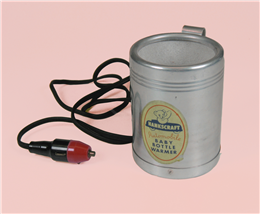Asbestos Baby Bottle Warmer
Wisconsin Historical Museum Object – Feature Story

Hankscraft Company's automobile baby bottle warmer, c. 1955
Source: Wisconsin Historical Museum object #1979.316.21

Interior of the baby bottle warmer, c. 1955
A detail of the warmer's interior shows the lining of asbestos that was used to insulate the baby bottle. Source: Wisconsin Historical Museum object #1979.316.21

Excerpts from Ladies' Home Journal
Excerpts from the same ad in the November 1959 issue of Ladies' Home Journal show two different types of bottle warmers offered by the Hankscraft Company. Source: Wisconsin Historical Museum Reference Collection
Automobile baby bottle warmer lined with asbestos, made by the Hankscraft Company, Reedsburg, Wisconsin, c. 1955.
(Museum object #1979.316.21)
At the height of the Baby Boom, convenience items like this Hankscraft brand automobile baby bottle warmer proved popular for many new parents. Following World War II, newly available scientific and technological advancements combined to develop products that made childrearing both safer and easier than ever before. Baby bottles, for example, made feeding an infant not only a task that could be shared by all, but one that could be done more conveniently by a family increasingly on the go. Warmers like this one assured the baby's comfort and happiness on the road as well as at home.
Travel bottle warmers became perfectly fitting accessories for an era noted for new ideas on how to handle nearly every aspect of infant care. Beginning with the birth itself, post-war mothers almost exclusively chose the safe environs of the hospital for the birthing process as opposed to home as earlier generations had done. Women could now also avoid the pain associated with labor thanks to innovations in anesthesia. Upon her return home, a new mother could count on the consoling words of the 1946 bestseller Common Sense Book of Baby and Child Care by childrearing guru Dr. Spock to reassure her that by merely following her natural instinct she was doing everything correctly to care for her newborn.
No longer constrained by traditional methods, once home a mid-twentieth century mother had either the option to feed her child breast milk or to choose the latest in scientifically advanced formulas. While breast milk substitutes (largely derived from cow's milk) had existed for decades, they were not only far less nutritious than breast milk, they were often biologically harmful due to microorganisms in the milk or contamination from the unhygienic bottles used to feed an infant. Even if a child did not suffer from germs picked up through the milk and his bottles, early substitutes made him far more prone to diseases like rickets that resulted from malnutrition.
By mid-century, the development of "scientifically perfect" powdered formula like Bremil by Bordens along with other new options, such as sterilized evaporated milk, gave mothers reason to use an artificial substitute to feed their babies. With the handiness of no-refrigeration-required varieties now easily found in a can, breastfeeding began to acquire the reputation of being old-fashioned and backwards. In an increasingly consumer-driven society with the woman typically acting as the primary purchaser for the household, convenience ruled. It was not until the women's liberation movements of the 1960s and 1970s, which strove to do things like restore a more natural mother-child bond as well as fight the traditionally patriarchal world of medicine, that many mothers would again return to breastfeeding.
As time would prove, the latest in modern conveniences and scientific advancements used during the 1940s and 1950s did not always end up being healthful in the long run. In an age where children played with mercury in their science kits, melted lead to make toys, and had their feet readily X-rayed in shoe stores for proper footwear fitting, the use of exposed asbestos as an insulator in this baby bottle warmer hardly seemed problematic. Even though there had been suggestion that asbestos was harmful as far back as Roman times, and much stronger evidence available by the 1940s and 1950s, it was not until the late 1970s that the use of asbestos in commercial products began to be limited in the United States. At the time of this unit's production, the lure of a bottle warmer that was designed to hang anywhere in the car and required only a 6 volt cigarette lighter to operate was seemingly reason enough to purchase this handy item.
The Hankscraft Company, originally of Madison, Wisconsin, initially found its marketing niche by designing a variety of novel home goods in the early 1920s, such as electric egg poachers and baby bottle warmers for home use. By 1949, the company moved its operations to the town of Reedsburg where it continued to produce small domestic goods and appliances like warming dishes for baby food, humidifiers and lamps, as well as a growing variety of baby bottle warmers for home and away. The Hankscraft Company still exists as Hankscraft Inc. in Reedsburg, although today the company focuses largely on building advertising displays and custom motorized objects.
Learn More
Have Questions?
For more information or to purchase an image of one of the objects featured in Curators' Favorites, contact our staff by email below:
[Sources: Fontanel, Beatrice and Claire d'Harcourt. Babies: History, Art, Folklore (New York: Harry N. Abrams, 1996); Weiner, Lynn Y. "Reconstructing Motherhood: The La Leche League in Postwar America" in Mothers and Motherhood (Columbus: Ohio State University Press, 1997);Barbalace, Roberta C. "A Brief History of Asbestos Use and Associated Health Risks," October 2004]
ALH
Posted on May 08, 2008

